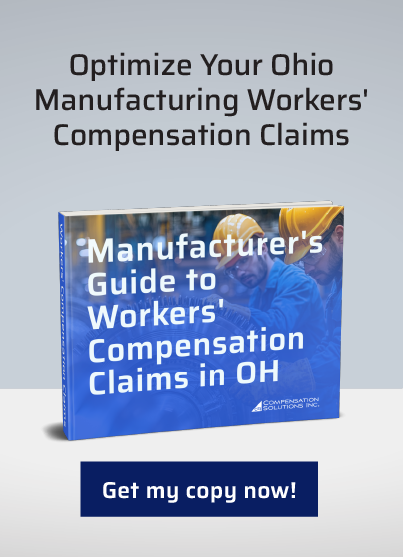Cost-Saving Strategies to Reduce OH Mfg. Workers Comp Premiums

In Ohio, businesses are required to buy workers' compensation insurance, which helps financially support employees who are injured on the job. Workers' compensation is a lifeline because it covers medical expenses and lost wages. However, workers’ comp premiums can be expensive for employers. Finding ways to reduce costs while keeping employees safe is critical.
Workers’ Comp Premiums Records
When you want to lower your insurance premiums, it means working with Ohio’s Bureau of Workers’ Compensation (BWC), as it’s the final arbitrator to lower your premiums. You need to convince the agency that your workplace is safe and that you are being proactive in reducing injury rates.
The first step in lowering your premiums is to keep accurate records. Keep everything organized and stored safely. The BWC prefers organized businesses when considering less expensive premiums. Essential records are as follows.
First Report of Injury (FROI-1)
FROI-1 records are the first reports of injury that a worker uses to notify you and the BWC of a work-related injury. Keep detailed information about each workplace injury; the time, date, location, and description are essential.
When lowering your premiums, the BWC will see how many workplace injuries that you have in a year. Safe workplaces with few injuries mean less expensive premiums for the company.
Employer Reports
As a business owner, you should record your side of the story in any injury documentation. Document employee behavior, the precautions that you took for workplace safety, and any staff or management violations of safety. Be honest and complete in these reports to encourage trust from the BWC.
Correspondence and Other Documents
Starting from the first injury report, keep copies of all claims, medical reports, doctor's notes, billing, and other documents related to worker injuries or treatment. Request these from your employees to facilitate quicker worker compensation, accurate payments, and timely reporting to the Ohio BWC. A record of resolving compensation quickly and accurately shows the agency that your business is organized, effective, and competent.
Recordkeeping
Do not omit any records just because you may think them insignificant. To the BWC, everything is relevant. Without proper documentation, it cannot judge your business’s injury rates, dedication to workplace safety, and effectiveness. Have backups of every document in different locations. According to Ohio workers' compensation law, accident reports should be retained for six years, and workers’ compensation files need to be retained for ten years after final payment. Consider using a cloud service for all records.
Reviewing and Updating Workers' Comp Premiums
In Ohio, you need to review and update your insurance policies every year because your accident and injury levels may change. Lowering your workers’ comp premiums depends on your annual safety record and overall commitment to having a safer workplace. Reviewing your yearly policies can also help you learn about programs like the Small and Large Deductible Programs, which give employers opportunities to lower their workers’ compensation premiums by paying a deductible. Another incentive, the Group-Retrospective-Rating Program, offers employers a premium adjustment after the policy year ends. This is based on performance in controlling the frequency of injuries and injury claim management.
Workplace Safety and Insurance Premiums
Reducing premiums is about commitment to workplace safety. Ohio has several programs to help businesses reduce workplace accidents and save money. Reducing substance use in the workplace, offering resources for employees in high-risk industries, and providing risk management essentials that enable participants to attend classes can cut your premium costs.
Substance Use Recovery and Workplace Safety Program (SURWSP)
The SURWSP program provides funding to help employers manage workplace substance use issues. With its Recovery Ohio partnership, the reimbursement funding is for employer policy and procedure development. It includes legal policy and procedure reviews, training, and recovery-focused policies. Employers can access a free employee wellness incentive program, the Better You! Better Ohio! Program.
Better You, Better Ohio!®
This program is for small business employers with 250 or fewer workers in high-risk industries like construction and agriculture. It helps prevent injuries through improved workforce health and safety and reduced absenteeism. Healthy employees are less prone to injuries, which can drive up premiums. Reducing severe incidents, improving recovery times, and decreasing time away from work are essential to the program.
Drug-Free Safety Program (DFSP)
The DFSP is a voluntary safety program created to address workplace use and misuse of alcohol and other drugs. It offers a limited number of grants to employers for developing drug-free policies and procedures within their workplaces, and it’s open to public and private organizations. This drug-free safety program encourages employers to establish drug-free policies so fewer accidents occur, which lowers insurance premiums.
Risk Management Essentials Pilot Program
This program helps participants in BWC’s Safety Council program, which enables employers to earn an added premium bonus through worker attendance in educational classes administered by sponsors. To be eligible, employers must attend ten out of twelve monthly safety council meetings. Six hours of additional safety and claims management training are necessary. Attendance earns employers a 5% discount on their premiums, up to $25,000.
Return-to-Work Programs
Return-to-work programs reduce time off and costs and make workplaces safer by keeping senior employees available for training and advice for newer employees. Ohio’s Transitional Work Grants help employers develop a transitional work plan that suits their business and workers. These give job duties to an injured employee who has job restrictions resulting from a work-related injury. The goal is for the person to gradually return to their original tasks.
Ergonomic Equipment
Using ergonomic equipment focuses on creating work environments that reduce strain and the risk of injury. To improve company safety and lower premiums, the BWC offers occupational safety and health consultations, including OSHA ones, at no additional cost. With these, employers can make their workplaces safer.
Third-Party Administrators (TPAs)
TPAs are useful businesses that can help you lower your BWC insurance premiums. A TPA in Ohio can help you find rewards programs for safe workplaces, provide policy guidance, and educate you about local rebates and discount programs. One example is the BWC’s “Destination: Excellence,” which rewards business safety and helps injured workers get healthy and back to work. This program provides rebates through successful program completion.
Your TPA is an advocate in the workers' compensation process. A successful partnership can significantly reduce your stress during claims processing and yield substantial annual premium savings for your company.
Self-Insurance Exceptions
Under limited circumstances, large companies can self-insure for workers’ compensation, but they need legal permission from the BWC. For self-insurance, employers must be financially strong and stable, have at least two years of Ohio State Insurance Fund experience, and have an Ohio-based office to manage workers’ compensation claims. Employees must still file a FROI-1 with the BWC in case their employer fails to meet their obligations. If this happens, they can file a complaint to revoke the company’s self-insured status.
Conclusion
Lowering your insurance premiums means keeping complete and organized records, investing in programs and policies for a safer workplace, and reviewing your insurance policies annually. Your dedication to worker safety can give you less expensive insurance and peace of mind.
Managing workers' compensation claims in Ohio shouldn’t be a headache. Partner with CSI to take the hassle out of claims, lower costs, and stay compliant with Ohio BWC regulations. Focus on your business and employees, and let our seasoned experts guide you through the complexities of workers' comp. Contact us today to streamline the process and experience stress-free claims management!

